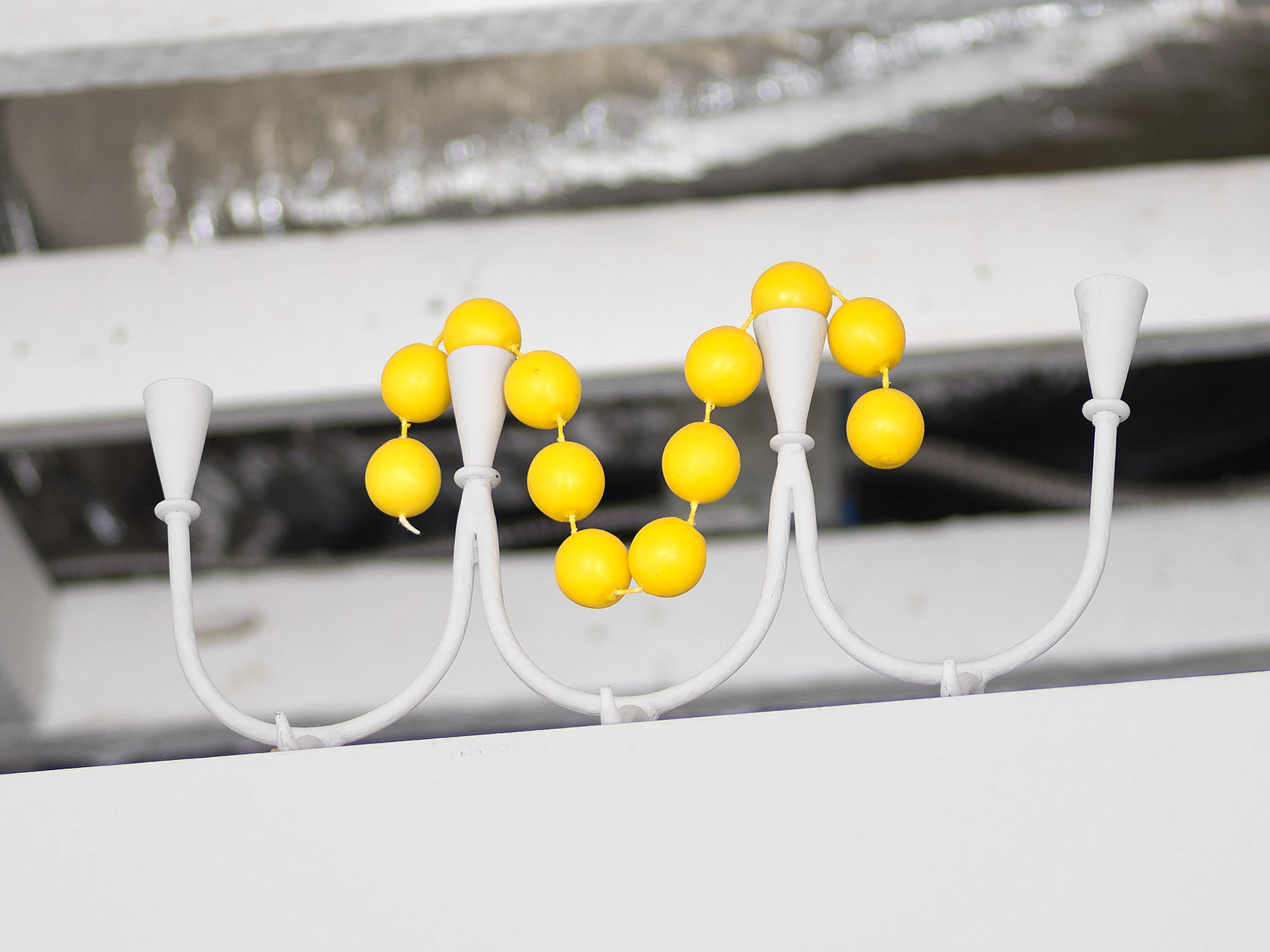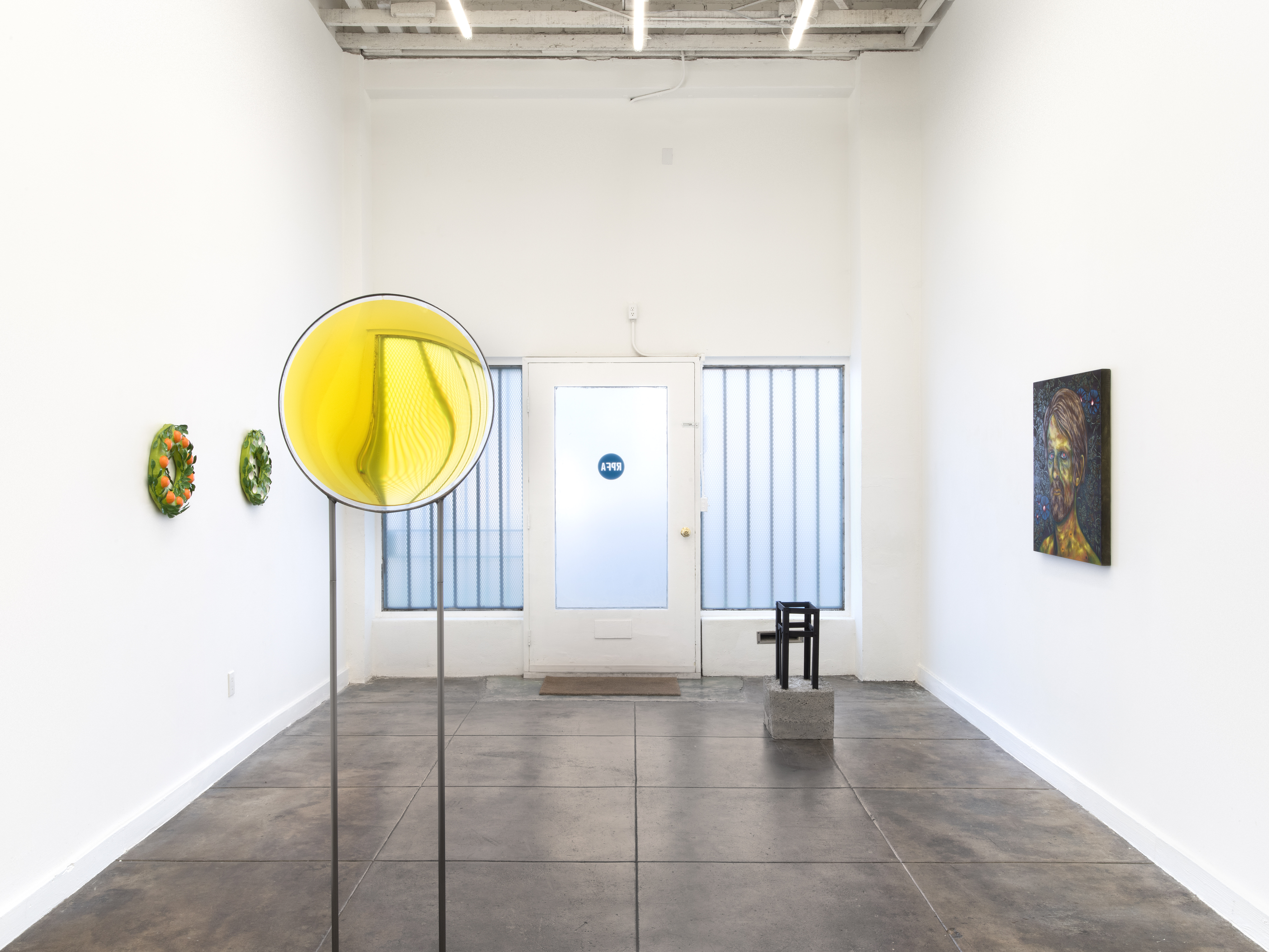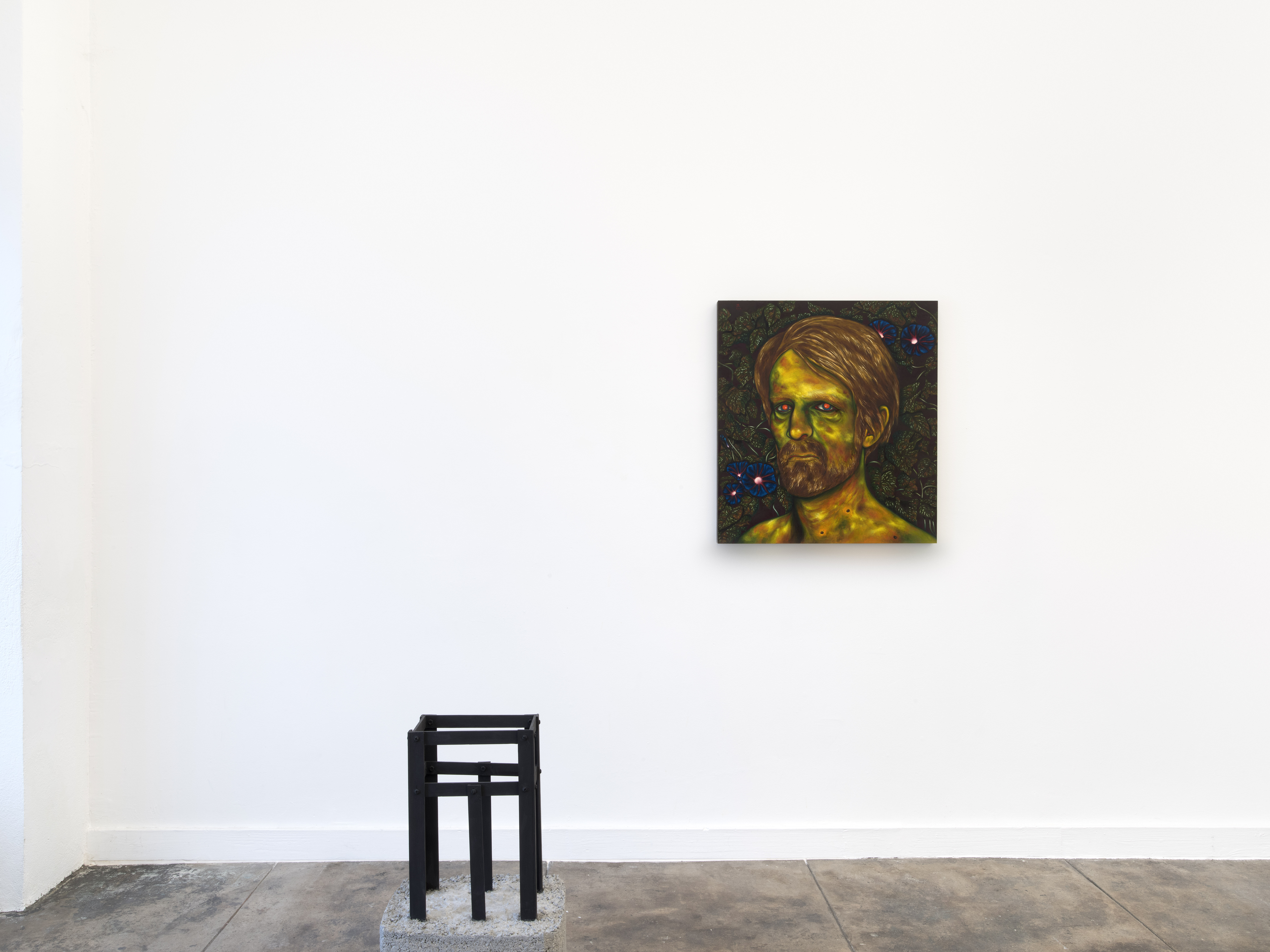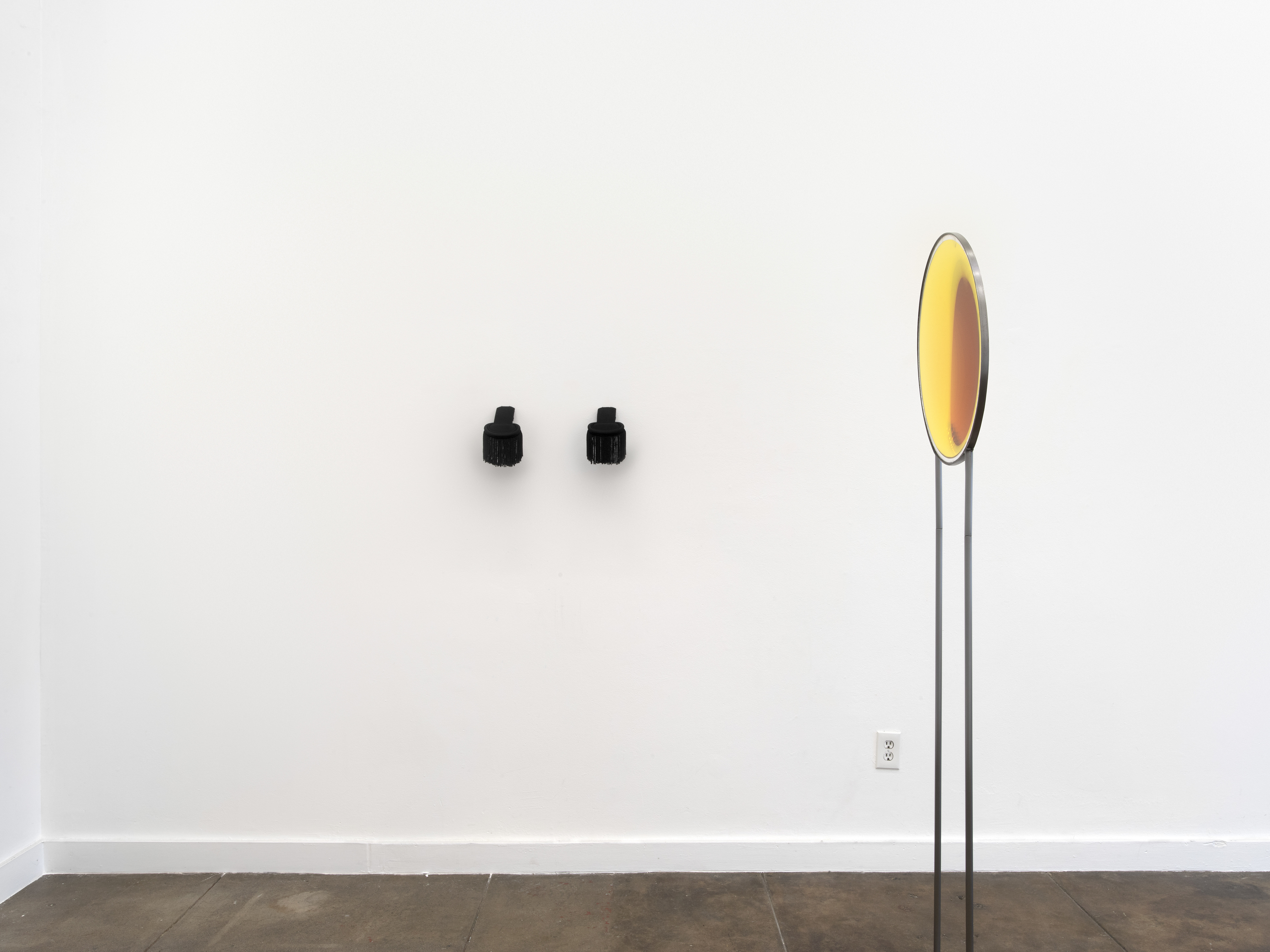







No-“Q”-No
Real Pain Fine Arts
New York, NY
November 2019
Works by: Tom Allen, Anna Helm, and Shana Lutker
Link ->
On the third Sunday after visiting Tom Allen’s studio, the bright, somewhat ecclesiastical quarters of a fully-turreted, 1930's châteauesque dwelling, I found his flowers. I was walking on a nondescript block of La Brea Ave, deep in conversation with a friend, when I turned to see a tree erupting in neon pink silk-floss. That this specimen would be here, on the street, was as surprising as the fact that were it not for Tom, I’d never look twice at them. Over the the past few years, flowers, many of them in direct proximity to his studio, have been Allen’s primary preoccupation. While his paintings suggest a naturalist bent in supplication over a rare specimen, he works instead from rather pedestrian photos, often gathered at night in an attention-drawing burst of flash. His paintings function, like their subjects, on a biological level, their rapturous colors, brighter than any phone screen, brazenly offering sex. To use them as he has, in the service of this modified history of painting, evokes a mad carney (or casino owner), stacking flashing marquee into the periphery, their persuasive dominion total and unrelenting. But sexual selection dictates that a display like this must attract and imperil in equal measure. Sticking your neck out is, well, sticking your neck out. In that sense, his choice of subject highlights the artist’s fundamental, and profoundly human, bid for attention—good, bad, or otherwise.
Allen’s 2014 painting, “Morning Glories,” puts its flora to another use entirely. In this picture, shown in LA for the first time, Allen’s flowers create a gloomy, Rousseau-ian backdrop. They evoke the strange but fairly typical scene (here, anyway) of movie-shoot day for night. Like a Highland Park streetcorner bathed in megawatt sun, it might be morning, or it might not. Clumps of the titular flowers frame a bruised, queasy figure, eyeballs lit from demonic possession or cheap flash, a trio of moles (or are they lymph nodes?) eerily aglow. He wears the expression of a man resigned to the casual indignities of middle-age, his hair in the style of the lurid 1970’s film gels that might be lighting up his face. These were the colors, yes, of Dario Argento’s nightmares, but also of Jean-Jacques Beineix’s punks, Alan Rudolph’s LA drifters, Lina Wertmüller’s nazis, Andrzej Żuławski’s hysterics, Ken Russell’s vampires, and the boudoirs of exploiters like Tinto Brass, Russ Meyer, and Masaru Konuma. Where today's video filters essentially point outside the frame, to, most commonly, the hand of a cynical manipulator, these melodramatic washes operated within, amplifying the emotional state of the actor. "Morning Glories" is, happily, more or less a window in the traditional sense. On the other side of that window is Allen, headphones pumping death metal, beautifully high on his own supply.
Tom Allen (b. 1975, Springfield, Massachusetts) lives and works in Los Angeles. Recent solo exhibitions include: (2019) La-bas, Lulu, Mexico City and (2017) The Lovers, Bel Ami, Los Angeles. Recent group exhibitions include: (2019) Dreamhouse vs. Punkhouse, Serious Topics, Inglewood, CA; (2017) Symbolisms, Cooper Cole, Toronto; Witch-Ikon, Mortlake & Company, Seattle; Therianthropy, Laura Bartlett Gallery, London; Ruins In the Snow, High Art, Paris; (2016) A Change of Heart, Hannah Hoffman Gallery, Los Angeles; Outside, MiM Gallery, Los Angeles. His work can be found in the permanent collection of the Museum of Contemporary Art, Los Angeles, the Sweeney Gallery at the University of California, Riverside, and in numerous private collections.
Anna Helm works out of a shed in Studio City. All around her, the fantasy machine hums.
This isn’t La La Land, but prosaic, workaday LA; offices, lots, and condos for actors, aspiring actors, agents, and other entertainment workers. Driving to visit her there, past billboards announcing the latest sitcoms and broad comedies to the same people who make them, I get the feeling she has synthesized this place—if not the stuff of it, its logic. There’s a reason why dystopi
an fictions start with the crowded retail spaces of this city, its architecture scripted like a stage play from which the sole vantage point is the interior of a moving vehicle. These frontages propose an encounter and a transaction, but also a perceptual arrangement. Helm’s sculptures—a string of bananas compressed into a used-car-lot rope, a trio of “palm-pom” trees growing their own skirts, an exterminator-wrapped Christmas tree emblazoned with a mysterious phrase, a freestanding scrying glass made of suspended olive oil, a series of newspapers, splattered haphazardly with the droppings of an indifferent bird—take up the mantle of art that has, for decades, played with this spatial quandary. At the same time, they are rooted in a private language that comes from a closed, familial realm. She also makes objects, like a series of “rock-phones,” that are small and personal, interminably inward, self-referential, and de
liriously solipsistic. They are a picture that is a sign, a word that is a picture, an object that is a word and a thought, a perceiving and decoding of a word, that, itself, has volume, shape and texture.
Here, Helm exhibits 3 new wreath-like works. These ersatz topiary rings are not quite clocks (2 citrus globes shy of 12), not quite moon charts (unless for a perpetual first-quarter), and, like so much holiday stuff in a desert climate, not quite wreaths. What appears to be plastic is in fact painted aluminum, or, in the case of a tennis-themed piece (another so-cal preoccupation), found gumballs. That the globes they enframe might be chocolate oranges, moons, cheshire-cat eyes, earth beneath our feet and food in our mo
uth, suggests scale shifts as wide as their subject is narrow. Helm insists that these sculptures have subjectivity; situating them in a space then becomes a discursive exercise, or what she calls a “show-and-show dialogue.“ She has a habit of
inventing words and then using them casually in conversation, as though uttering them manifests their meaning. In writing about her work she tellingly notes that these pieces change “depending on what they’re next too.” Like everything she makes, what appears to be a typo warrants a second look, a turn of the head, at these “o’s”—word-objects, eyes, a stuck key, repeating, run-on globes, inscribing two adjacent bodies on the page.
Anna Helm, b. 1991, lives and works in Los Angeles. She graduated from the University of Southern California in 2013 and has shown her work at Midway Contemporary Art, Minneapolis, Moody Center for the Arts, Houston, The Vanity Gallery East, Los Angeles, and Between Arrival & Departure, Düsseldorf.
Shana Lutker’s studio is full of photos, if you know where to look. Situated somewhere between artworks, source material, and an “outside” to the performative space of her sculptures, they stick out from folders, mark interesting spots in books, and generally punctuate her object-sentences. Her subjects are bits of broken down fencing, overturned tables, articles flattened by indifferent footsteps and other urban curios. They reflect the obsessions for which she is known, namely the photographs and photograms of the Surrealists, but also a deep fetish of the interstitial, a love of fixtures, ad-hoc amalgamations and every bit of rusty wire that says “nothing to see here.” Like those bygone images, they give the impression of a child, who, tired of rectangles, triangles and circles, is wandering the neighborhood looking for more shapes. They tell another story about her cutout sculptures, with their sleek mirrored surfaces, pointing the viewer simultaneously at themself and “somewhere else.” Lutker’s use of historical material is not a form of quoting but rather a praxis, a self-conscious restaging of the political and aesthetic terms of other times. The difference between these two strategies is huge. It means that viewing her work is less about “needing to know” and more about encountering something that is, itself, materially instructive. It means that this thing is this size, looks one way or another, is made of or with this or that, for reasons that are not only rooted in history, but also produce old feelings (or as Joan Didion puts it in her 1977 essay on The Getty, “Ancient marbles were not always attractively faded and worn… [they] once appeared just as they appear here: as strident, opulent evidence of imperial power and acquisition.”)
Here Lutker is less intentional, less restrained. In a work from 2019 titled "AHMAHM-," thin pieces of pine are painted black and embedded in concrete, creating an uncomfortable imbalance of weight and integrity. The inspiration was an ambiguous structure the artist noticed in her neighbor’s yard. Without evidence of a clear purpose or functional imperative, the structure became an enigma, and she “knew [she] had to make it to understand it.” In another work, "Curtain (Oh, and Smile)," a large piece of lead is folded like a shower curtain, or, perhaps, a ruffled gown from a Botticelli painting. It hangs from a found brass railing, bent dramatically in some unseen event. We know the lead is heavy, and we also know it had nothing to do with the state of the railing, and yet, here it is. The ham-fisted eloquence of this work is heightened by a circular cutout; an acme spurl to the curtain’s priggishness. There’s a thing the mind does when it’s shuffling through words, trying to settle on the right one. Having settled, then, it is free to wander, pulling the word apart, taking in its dumb blunt sounds, weight and shape, sensory delights. These works exist somewhere in the middle, perhaps at the moment just before recognition, when their arcs, angles and lumps register something, but only something.
Shana Lutker is a Los Angeles-based artist. She received a BA from Brown University and an MFA from UCLA in 2005. Solo exhibition venues include the Hirshhorn Museum and Sculpture Garden, Pérez Art Museum Miami, 18th St Arts Center in Santa Monica, and Vielmetter Los Angeles. Lutker’s work was included in the 2014 Whitney Biennial, Performa 13 and many US and international venues including the SculptureCenter, Hauser & Wirth, CCA Wattis Institute for Contemporary Arts, Moscow Museum of Modern Art, and Orange County Museum of Art. Her work has been covered in Art in America, Artforum, Artillery, Blouin ArtInfo, Frieze, Hyperallergic, Los Angeles Times, and The New York Times, among others. Her work is currently on view in “Museum of Modern Art and Western Antiquities, Section II, Department of Carving and Modeling: Form and Volume” at Cristina Guerra in Lisbon, and “The Enchanted” in Laing Art Gallery in Newcastle, England. She is represented by Vielmetter Los Angeles.